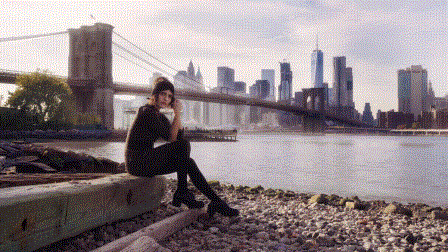What’s happening with the cinemagraph?
We checked up on whether this photo+video format is catching on.
This, the age of merging media formats, has appropriately given birth to a video-photo.
Or, rather, husband and wife fashion photographers Kevin Burke and Jamie Beck did five years ago, presenting the first cinemagraphs in the fall of 2011 at Fashion Week in New York.
Using PhotoShop and After Effects, they frame-by-frame composited a photo with a bit of movement that looks like a moment partially frozen in time, wagging some highlighted detail. Initially presented as a GIF animation, it is more commonly shown today as a video file because the quality is better.
In February of last year, Facebook began promoting their use in that social network as an eye-catching alternative to video. “You’re going to start seeing a ton of these on Facebook,” an ad exec told AdWeek. Flixel has integrated its iOS mobile cinemagraph-creating app into the Facebook Ads Manager, so the moving photos can be created inside Facebook.
(We reached out to Facebook to check on cinemagraphs’ success there but haven’t yet heard back.)
Robert Lendvai, CMO of cinemagraph tool vendor Flixel, paints a picture of the format being used in ads by a wide range of brands, including HBO’s “Silicon Alley” TV series, Disney, Coca-Cola, Mashable, The Emmys, Entertainment Weekly, Walmart, Doritos, Dos Equis and others. The Toronto-based company says its Mac and iOS tools for cinemagraph creation are the only professional-level ones.
A creator shoots a video clip up to 10 seconds on a tripod, imports it into Flixel’s software, picks a still frame from the video as the photo, and then employs a patent-pending masking tool that brushes the video over the still photo.
The evidence is that a number of brands have used the format, sometimes experimentally and sometimes repeatedly as an eye-catching tool for such contexts as mobile news feeds in social media. In general, the results of user engagement indicate that cinemagraphs have unique appeal and will likely continue as a niche format.
At the end of last year, for instance, Microsoft launched an eight-day test campaign to promote Surface products on Facebook, Twitter and Instagram aimed at small and medium-sized businesses (SMBs) and consumers. An A/B test compared ads with cinemagraphs against the same ones with still images.
The tech giant reported an 85 percent increase in engagement among SMBs for ads with cinemagraphs, compared to 0.83 percent for those with still images. On Twitter, for SMBs, Microsoft found a 110-percent engagement rate increase for ads with cinemagraphs compared to those with still images, and, on Instagram, there was a 45-percent decrease in cost per engagement.
“I’m astounded by the results we have seen with cinemagraph ads,” Flixel quoted Linda Chep, demand gen marketing manager at Microsoft.
Flixel also points to PepsiCo’s 2016 campaign promoting Mist Twist on Facebook with cinemagraph-based ads. Kelli McIntosh, senior marketing manager for digital customer solutions at Pepsi, told me via email: “[W]e were blown away by the results” in this test campaign.
“The cinemagraph had a 75 percent increase in CTR and 51 percent increase in engagement vs. the static image,” she said. “They generate just enough curiosity to stop thumbs in their track[s].”
A&E created black-and-white cinemagraphs to promote on social media its TV series, “Bates Motel,” based on Hitchcock’s “Psycho.” On Facebook, the cable network said that it reached 1.7 million users and that its highest-engagement posts on Tumblr have been cinemagraph-enriched ones.
In Flixel’s home country of Canada, ad agency Critical Mass created a 2015/2016 campaign for Travel Alberta:
Marketing Land – Internet Marketing News, Strategies & Tips
(55)















